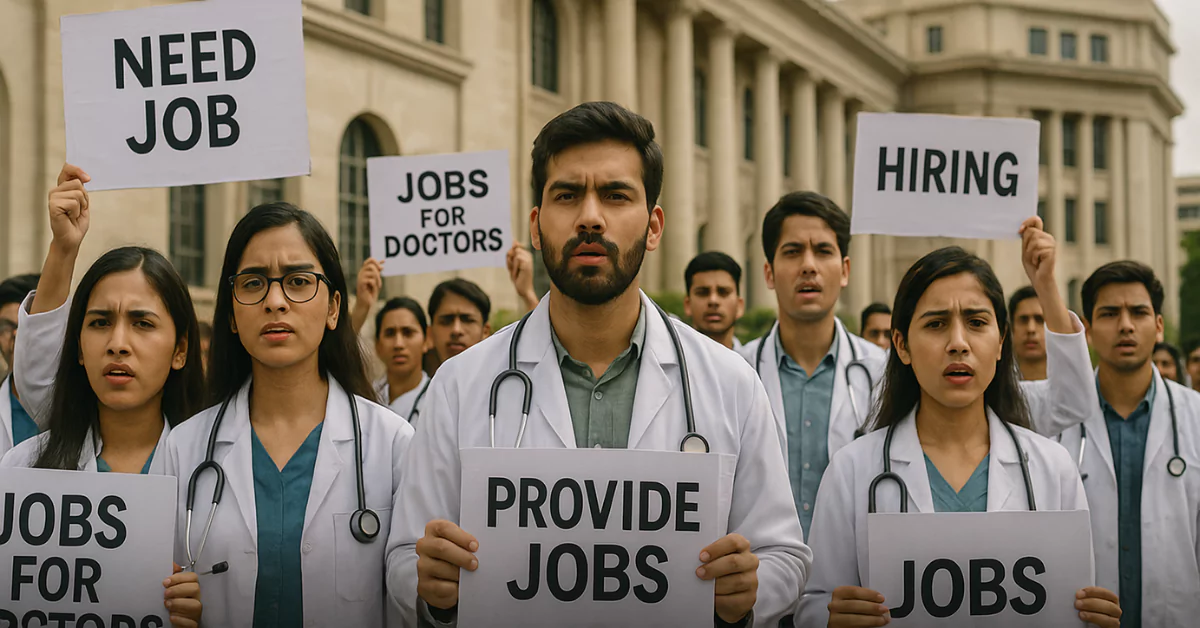MBBS Doctor Crisis in India: By 2030, India is expected to have an additional half a million MBBS-qualified doctors. Currently, more than 1,00,000 doctors graduate from Indian medical colleges every year. This sounds like good news in a country with around 1.5 billion people.
However, the reality is different. Despite the growing number of doctors, a significant portion of them are either unemployed, under-employed, or stuck in years of career stagnation.
In this article, we will explore why thousands of new doctors in India are not being productively absorbed into the healthcare system, the crisis of leadership in the medical profession, and what needs to change.
The Illusion of Doctor Shortage
There is a popular belief in India that we have a shortage of doctors. But the numbers tell a different story.
With 780+ medical colleges (the most in the world), India is producing more than 1,00,000 MBBS doctors annually. At this rate, by 2030, India will have one million more doctors than it had in 2020.
So, where are these doctors going?
- Are they not willing to serve the people?
- Are they going abroad?
- Are they only interested in working in cities?
No. Many are simply not being given opportunities to work where they are needed.
Where Are the Jobs?
Public Sector Has Limited Capacity
In states like Bihar, hundreds of MBBS graduates apply for a single government job with a salary of ₹35,000-₹45,000 per month. The number of available posts is much lower than the number of doctors looking for jobs. The government health system is not expanding fast enough to absorb the existing medical workforce.
Private Sector Pays Poorly
In major cities like Mumbai, Bangalore, Hyderabad, and Chennai, private hospitals offer starting salaries lower than what call center employees earn. Many MBBS doctors get only ₹15,000-₹25,000 per month, which is not enough for even a lower-middle-class lifestyle in urban India.
No Campus Placements
Surprisingly, there are no campus recruitment programs for doctors, not even at prestigious institutions like AIIMS. After spending 5.5 years in MBBS, graduates are left to struggle on their own for jobs or further study.
The Postgraduate Trap
Due to the lack of job opportunities, most MBBS graduates spend the next 5-10 years preparing for postgraduate entrance exams. These years, which could be used for working and gaining clinical experience, are wasted in coaching classes and repeated exam attempts.
This creates a dysfunctional system where:
- Doctors are not contributing to healthcare delivery.
- Communities remain underserved.
- Young lives are stuck in uncertainty and stress.
Is This a Systemic Design?
Some experts argue that this situation is not accidental. They believe that keeping doctors out of the system:
- Maintains high levels of illness in the community, forcing people to seek expensive hospital care.
- Supports medical industry profits through increased use of tests, procedures, and medicines.
- Prevents the development of a strong, publicly accountable primary healthcare system.
The Leadership Crisis in the Medical Profession
India once had great physician-leaders like Dr. Bidhan Chandra Roy, the former Chief Minister of West Bengal. A respected doctor and freedom fighter, he helped shape India’s medical profession by building institutions like the Indian Medical Association (IMA) and Medical Council of India (MCI).
Today, however, the profession lacks true leadership.
Instead, we see:
- Celebrity doctors represent corporate interests, not the concerns of common doctors.
- Professional organisations that are controlled by hospital owners, not practising doctors.
- Deans and principals are too busy meeting regulatory requirements, without any national health vision.
Most frontline doctors, general practitioners, resident medical officers, and family physicians have no voice or representation in national medical councils or policy-making bodies.
Even worse, MBBS doctors are legally barred from becoming teaching faculty in medical colleges unless they have postgraduate degrees, further limiting their career paths.
Read Also: India’s Medical Education Revolution: NMC Reforms, CBME, NEXT & More
Policy Bias and Power Influence
Historically, cardiologists and cardiac surgeons have had an outsized influence in shaping India’s health policies. One reason could be that many Indian politicians, who are older, are more concerned about heart disease, so they often consult with these specialists. In a country where evidence-based policy-making is weak, access to a powerful person often matters more than data.
Industrialisation of Medicine
Due to unregulated business practices, the health sector in India is becoming increasingly commercialised. This has led to:
- Rise in malpractice and unethical behaviour.
- Erosion of public trust in doctors.
- Shift of doctors’ loyalty from patients to industry sponsors.
Rather than standing up for patients, many medical leaders are defending their corporate interests.
A Broken Pyramid
The medical profession in India is becoming a rigid pyramid:
- A few super-specialists at the top (cardiologists, neurologists, etc.)
- Thousands of primary care physicians and MBBS doctors at the bottom
But this structure is not serving the needs of a country like India, where 80% of health problems can be solved at the primary care level.
Yet, vocational training and long-term career opportunities for primary care physicians have been ignored by regulators and policymakers.
What Needs to Change?
Job Creation in the Public Sector
The government must urgently expand public health services, especially in rural and semi-urban areas. Vacant posts must be filled, and new posts created.
Decent Salaries for MBBS Graduates
Private hospitals must be encouraged or regulated to offer dignified pay to young doctors. Public sector salaries also need an upward revision.
Postgraduate Seats and Alternate Career Paths
More PG seats should be created. At the same time, non-PG pathways for MBBS doctors to grow in primary care, teaching, or research must be institutionalised.
Leadership Development
Medical students and young doctors should be trained in public health, leadership, and ethics so that a new generation of physician-leaders can emerge.
Reform in Professional Bodies
Professional organisations like IMA must be reformed to truly represent working doctors, not just industry lobbies or hospital chains.
The Call to Young Doctors
India’s young doctors must rise to reclaim leadership of their profession. They must:
- Speak up for patients and ethics
- Demand policy reform
- Create platforms for professional unity
- Raise your voice against exploitation by the government and the private sector alike
India does not lack doctors. It lacks vision, policy, and leadership. In a country with 1.5 billion people, no qualified doctor should remain unemployed. The problem is not the doctors; it is the system that fails to use them properly.
Dr. B. C. Roy once dreamed of a healthcare system led by doctors for the people of India. It is time to revisit that dream and turn it into reality.
Also Read: Global Medical Education Crisis: Doctor Shortage, Limited Access & Student Migration


